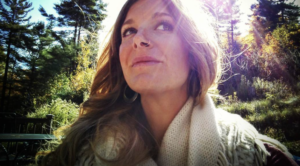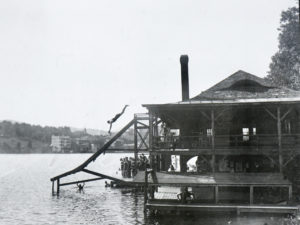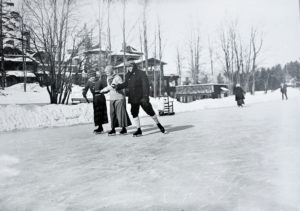
By Jessica Wimett
Mirror Lake has become synonymous with recreational activities, which grants Lake Placid a bustling community based around this myriad of outdoor pursuits provided by such a setting. Boasting full access around the 2.7-mile perimeter of the lake, sandy beaches with grassy inlets, playgrounds for children, and a ban on motorized boats; swimmers, boaters, birders and walkers can be ensured a serene experience. Mirror Lake also bridges the gap between seasons with its auspicious location. While warm weather brings with it a variety of water play, an autumn sunset reflecting on the water is a visual feast not to be missed, and wintertime provides unique sporting opportunities such as sledding, skating, and dog sledding on the frozen lake. With the annual Ironman upon us, the Mirror Lake Watershed Association wanted to take a look back at the history of recreational use on the lake.

According to Beverly Reid, the Lake Placid/North Elba Town Historian who has lived and worked in Lake Placid for her entire life; Mirror Lake has attracted outdoor enthusiasts as early as the 19th century, when the town was being developed around the iron ore mining industry. I interviewed Mrs. Reid for this article, and she happily recounted well-over a century of recreation along the lake. According to Reid, by the close of the 19th century there was an established group of local men who had started a popular horse racing group. This club began holding ice trotting races on the frozen lake in the winter, outfitting the horses with special shoes, and creating the course along the lake.
Around this same time, the locals had created toboggan chutes on the shores of Mirror Lake, with the outruns leading out across the lake in different locales. The first of these chutes began next to what is now the Mirror Lake Inn, leading brave sledders right across the road, and down onto the lake! These humble beginnings were the genesis for the abundant recreational opportunities around the lake that we know and love today.
Amongst this early recreational activity, Melvil Dewey founded the Lake Placid Park Club in 1895, which he established as a recreational and leisurely retreat for the wealthy. This club, which later shortened its name to the Lake Placid Club, drew in scores of people to the area and provided hundreds of summer jobs.

In Beverly Reid’s words, “The Lake Placid Club even established a ferry across the lake to carry visitors to the center of town. The loading dock was situated next to the Wanda building, and there was a little teahouse to serve passengers before their ride across the lake.”
In 1904, the club was kept open in the winter season to accommodate a small handful of adventurous members, and began the infrastructure that would later mark this area as one of the country’s leading winter sports destinations.
According to the publication, The Lake Placid Club: 1890-2002, edited by Lee Manchester; the most active winter sportsmen in the club founded a group called Sno Birds, who oversaw the building of wintertime activities and offered sponsorship to talented local athletes. Overseen by Henry Uihlein, the Sno Birds worked to establish the infrastructure and the program of winter events to create a substantial hype surrounding Lake Placid’s winter recreational opportunities.
As a result of 30 years of the Sno Birds efforts, Dr. Godfrey Dewey (Melvil’s son) decided that the area was prime to host the Winter Olympics, and in 1929, he organized a successful campaign to convince the International Olympic Committee that Lake Placid boasted the most promising winter sports facilities in the US. Resulting from these efforts, Lake Placid has been the two-time host of the Winter Olympics, both in 1932 and 1980 (whose medals ceremony was actually held on the Mirror Lake ice).
In addition to the activities sponsored by the Lake Placid Club, the villagers of Lake Placid themselves utilized their local treasure for their outdoor pursuits. According to Reid, in the 1940’s, a public skating rink was established and maintained in the middle of the lake with trees, lights, and a hockey box, that was used for public skating and hockey games. Admission to the rink was free, and it became so popular with school children that the NY Times did a write-up about it.

In the 1940’s through the 1960’s, temporary permits were issued for waterskiing races and motorboat races for town residents, but these were discontinued so as to keep the peaceful ambiance of the motor-free lake.
This rich history of recreation use brings us to 1999, when the World Triathlon Corporation selected Lake Placid for their longest-standing Ironman race in North America. The first leg of the race is the 2.4-mile swim in Mirror Lake, cheered on by scores of spectators lining the shores.
Presently, it seems that regardless of season, weather conditions or time of day, there can always be found people engaged in athletic pursuits in and around the Mirror. Therein lies the need for us to engage in our role as stewards and caretakers of this incredible natural treasure; because with the lake giving so much back to our health and vitality, we to must ensure that the health of the lake remains paramount.
To become involved in The Mirror Lake Watershed Association, please visit us at our website: http://www.mirrorlake.net
To see more pictures of the historical recreation on Mirror Lake, visit http://www.lakeplacidhistory.com, or go to the Historical Society Museum in person at 242 Station Street in Lake Placid.
